Planting Fruit Trees and How to Prune Fruit Trees - with Pictures
What would summer be without those delicious summer-kissed fruits? The apples, pears, peaches, plums and cherries are all deciduous fruits that make delicious ciders, wines, moonshine, jams, chutneys and preserves. So how do we plant these fruit trees to ensure success?
First of all you need to have the right climate, soil and plant fruit trees in the right position. Deciduous fruit trees do well in cool temperate climates that should not be gown in late frost areas, as frosts in the spring can kill your saplings quicker than you can imagine. If you live on the coast, your fruit trees could be susceptible to fruit flies which are deadly for your crop. It would be best here to make sure that you plant early-maturing varieties to help avoid this problem.
Planting Fruit Trees: Where to Plant
When planting your saplings out make sure that they are in a spot where they get full sun and have good drainage. Don't plant them too close to each other or to other trees so that they get good air-circulation. Fruit trees aren't that fussy when it comes to soil. However, if you prepare the holes first with some well-rotted compost and farmyard manure and a handful of blood and bone, your plants will thank you later on.
Planting Fruit Trees: When to Plant
Dig a hole large enough to take the roots comfortably. I once got my husband to dig a hole for an oak tree sapling 1m x 1m x 1m, which was we discovered afterwards, was far in excess of the space that it needed. But I tell you! That little oak tree never looked back!
When you place the tree into the hole spread the roots out in a natural way. Make sure that the hole isn't too deep so that the tree disappears into the abyss. The soil line should come just below that of the nursery soil line, keeping the bud union well above the soil line.
Back-fill the hole and firm the tree in by firmly pressing the soil down around the tree with your foot. Fill up with some more topsoil and water in well. To keep the moisture in the soil mulch around the tree with either some bark, or some compost. Do not place this against the trunk, but a couple of inches away, so as not to encourage disease.
Planting Fruit Trees: Ideal Growing Conditions
Fruit trees are great nitrogen feeders and is the element most needed by your trees. I don't like using chemical fertilizers. I usually apply either diluted nettle tea (1:10), which has been steeped in a bucket for about a month, commercial seaweed applications or diluted urine (1:10).
The nitrogen can be applied when needed and annually in late winter and early spring. A surface mulch of compost, old grass clippings and rotten animal manure will also help.
Pruning your Fruit Trees: Step-by-Step Instructions on How to Prune
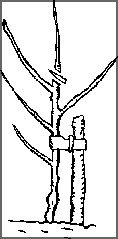 Planting Fruit Trees: How to
Prune a One Year Old Fruit Tree
Planting Fruit Trees: How to
Prune a One Year Old Fruit Tree
After planting, you need to know how to prune your fruit trees. Cut back the young tree to about 80 cm high to encourage the development of three main limbs. A vase shape is best for most deciduous trees. Prune trees hard for the first few years to make a sturdy framework and to shape the tree.
A one year old tree with no side shoots tree should be pruned to a bud with two buds below it at about 80 cm from the ground immediately after planting to produce primary branches during the first growing season.
A one year old tree with several side branches should have its main stem pruned back to three or four strong shoots at 80 cm from the ground. Side shoots should be shortened by two thirds of their length to an upward or outward facing bud. Lower shoots should be removed flush with the stem.
During winter remove the shoots that are growing inward. This allows for the sunlight to enter the center of the tree and helps to encourage flowers and fruit.
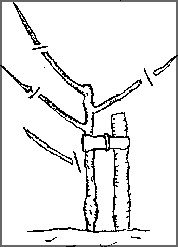
Planting Fruit Trees: How to Prune a Two Year Old Fruit Tree
When planting fruit trees that have grown for 2 years, remove any lower shoots and prune between three and five of the best placed shoots by half to an upwards or outwards facing bud to form what will become the tree's main structural branches.
Remove any inwards facing shoots.
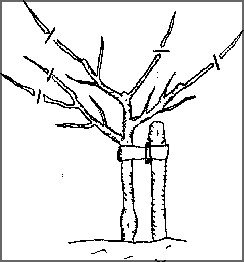
When planting fruit trees that have grown for 3 years you will need to prune the leading shoots of branches selected to extend the framework by half to a bud facing in the desired direction.
Select
four good laterals to fill the framework and shorten
these by a half. Prune any remaining laterals to four buds to form
fruiting spurs.
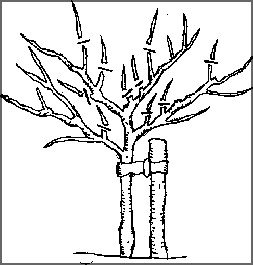
Planting Fruit Trees: How to Prune a Four Year Old Fruit Tree
The tree will have begun to fruit and only limited formative pruning is now required. Shorten leaders by one third and prune laterals not required to extend the framework to four buds.
When the fruit trees are fully grown it is important to remove all dead and diseased wood. Prune all deciduous fruit trees, except for cherries, in winter. Cherries, on the other hand, should only be pruned in spring just before they start getting their first leaves.
I don't have time to go into details here, but different kinds of fruit trees bear their fruit in different ways. Therefore it is important to know this before you go pruning your trees.
Distances Apart to Plant Fruit TreesDifferent fruit trees have different shapes and spreading capabilities, and therefore you will need to take this into consideration when planning your fruit orchards.
You will also have take into consideration certain varieties and whether you are planting dwarf fruit trees or standard fruit trees.
| Fruit Tree | Distance in Feet |
| Apple, Standard | 35 - 40 |
| Apple, Dwarf on Doucin Stock | 15-25 |
| Apple, Dwarf on Paradise Stock | 10-12 |
| Apricot | 4x6, 6x8 |
| Cherry Duke | 25-30 |
| Cherry Sour | 15-20 |
| Cherry Sweet | 30-40 |
| Fig | 20-25 |
| Grapefruit | 25-30 |
| Lemon | 25-30 |
| Loquat | 15-25 |
| Mulberry | 25-35 |
| Nectarine | 20 |
| Orange, Dwarf | 10-15 |
| Orange , Standard | 25-30 |
| Peach | 20 |
| Pear, Dwarf | 10-15 |
| Pear, Standard | 25-30 |
| Persimmon, Japanese | 20-25 |
| Persimmon, American | 25-30 |
| Plum | 20 |
| Quince | 10-15 |
Recommended Fruit Tree Varieties
| Fruit Tree | Variety |
| Apples | Benoni, Blenheim, Chenango, Cortland, Delicious, Early Harvest, Early Mackintosh, Esopus Spitzenberg, Fall Pippen, Fameuse, Golden Delicious, Golden Russet, Gravenstein, Grimes Golden, Hubbardston, Jonathan, Mackintosh, Northern Spy, Peck Pleasant, Porter, Primate, Rambo, Roxbury Russet, St. Lawrence, Shiawassee, Williams, Winesap. |
| Apricots | Alexander, Alexis, Blenheim, Budd, Early Golden, Harris, Montgamet, Moorpark, Peach, Royal, St. Ambroise. |
| Cherry, Duke | Late Duke, Louis Philippe, Magnifique, May Duke, Olivet, Royal Duke, Reine Hortense. |
| Cherry, Sour | Dyehouse, Early Richmond, English Morello, Large Montmorency, Ostheim, Wragg. |
| Cherry, Sweet | Bing, Black Tartarian, Burbank, Napoleon, Lambert, Govenor Wood, Schmidt, Windsor, Yellow Spanish. |
| Crab Apple | Excelsior, General Grant, Hyslop, Martha, Transcendent, Whitney. |
| Nectarine | Boston, Downton, Early Newington, Early Rivers, Early Violet, Elruge, Hardwicke, Humboldt, Hunter, Newton, Pitmaston Orange, Stanwick, Victoria. |
| Peach | Belle, Carman, Chairs, Champion, Early Crawford, Fitzgerald, Foster, Frances, Greensboro, Hiley, Late Crawford, Morris White, Niagara, Oldmixon Cling, Oldmixon Free, Ray, Rochester, Salwey, Stock, Stump, Waddell, Yellow St. John. |
| Pear | Anjou, Beurre Superfine, Clapp, Comice, Madeline, Josephine de Malines, Osband, Pound, Tyson, White Doyenne. |
| Plum, American | Desoto, Downing, Hammer, Hawkeye, Miner, Stoddard, Surprise, Terry Wayland, Weaver. |
| Plum, European | Bavay, Golden Drop, Imperial Gage, Italian Prune, Jefferson, Middleburg, Mirabelle, Pearl, Peters, Reine Claude, Shropshire, Tragedy, Washington, Yellow Egg. |
RECOMMENDED BOOKS ON PLANTING AND PRUNING FRUIT TREES
You can Add your Own Comments on Planting and Pruning Fruit Trees!
We have lots of pages where you can contribute to throughout this website. We love hearing from our readers, and hope you will be one of those we hear from too. Feel free to contribute to this page by adding your own tips, comments or advice on planting or pruning fruit trees. You can do this by using the form below.
Leave a Comment
Do you have anything that you would like to add after reading this page? We would love to hear your thoughts. If you can add additional information to what has been written here you will be adding value to the website! No need to have any special skills - just type and submit. We will do the rest!
Other Comments
Click below to see comments from other visitors to this page...
How to Prune and Feed Neglected Pear Trees 




Just moved into new home and found we have an old pear tree. It looks awful. How do we care for it? It also looks as if it has never been pruned.
…
Pruning apple trees Not rated yet
This information is very helpful for cultivating and pruning apples.
apricot growing problems Not rated yet
I have and apricot growing proble. I have an apricot tree, which blossomes at summer time(not spring) , then i see a few apricots. It is about min. 5 ys. …
Don't miss out on our latest news and articles. Sign up for our free monthly e-zine!
Go from Planting Fruit Trees back to Self-Sufficient Living
Go to Growing Vegetables
Go to Homesteading Today
Return to Countryfarm Lifestyles and Homesteading






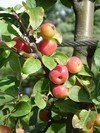
New! Comments
Do you have something of value to add? Leave me a comment in the box below.